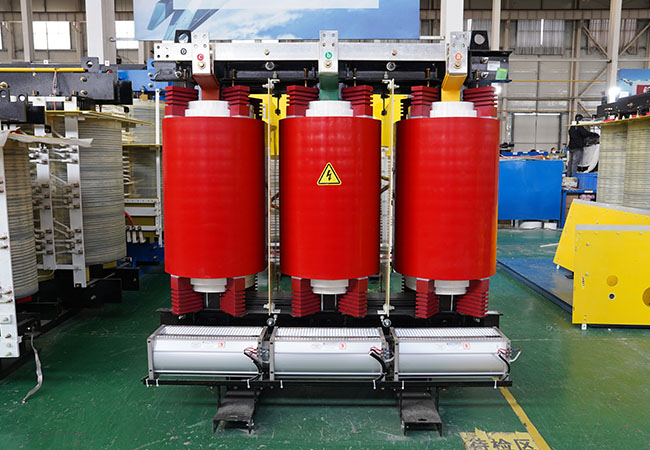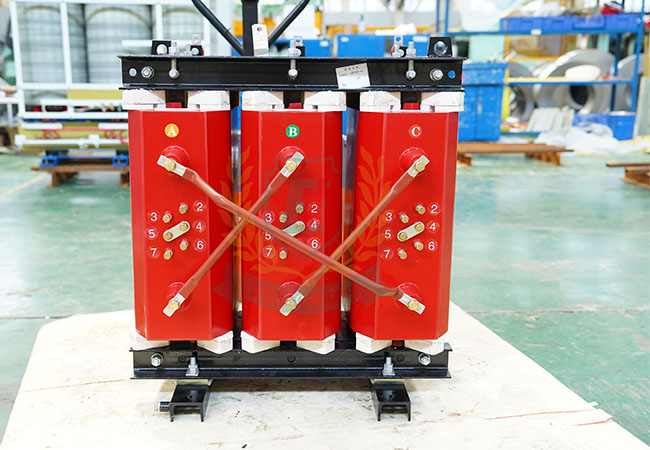Understand The Structure, Cooling Method, Installation And Commissioning Of Dry-Type Transformers In One Article
10-10 2024 | By:
A dry-type transformer refers to a power transformer whose core and winding are not immersed in insulating oil and adopts natural cooling or air cooling. As a late-emerging power distribution equipment, it has been widely used in power transmission and transformation systems in factory workshops, high-rise buildings, commercial centers, airports, docks, subways, oil platforms and other places, and can be combined with switch cabinets to form a compact complete substation.
At present, most of my country’s dry-type power transformers are three-phase solid-molded SC series, such as: SCB9 series three-phase winding transformers, SCB10 series three-phase foil transformers SCB9 series three-phase foil transformers. Its voltage level is generally in the range of 6-35KV, and the maximum capacity can reach 25MVA. For dry-type transformers, do you want to know more? The following Xianji.com editor will introduce in detail the structural form, cooling method, type, and advantages of dry-type transformers compared with oil-immersed transformers? Installation and debugging, how to judge faults from sound, noise caused by external structure and solutions, and selection points. Let’s take a look!
■ Structural form of dry-type transformer
1. Open type: It is a commonly used form. Its body is in direct contact with the atmosphere. It is suitable for relatively dry and clean indoors (when the ambient temperature is 20 degrees, the relative humidity should not exceed 85%). There are generally two cooling methods: air self-cooling and air cooling.
2. Closed type: The body is in a closed shell and is not in direct contact with the atmosphere (due to poor sealing and heat dissipation conditions, it is mainly used in mining and belongs to explosion-proof type).
3. Casting type: Epoxy resin or other resin casting is used as the main insulation. It has a simple structure and small size, and is suitable for transformers with smaller capacity.
■ Cooling method of dry-type transformer
The cooling methods of dry-type transformers are divided into natural air cooling (AN) and forced air cooling (AF). When naturally air-cooled, the transformer can operate continuously for a long time at rated capacity. When forced air-cooled, the transformer output capacity can be increased by 50%. It is suitable for intermittent overload operation or emergency overload operation; because the load loss and impedance voltage increase during overload are large, it is in a non-economic operation state, so it should not be in long-term continuous overload operation.
■ Types of dry-type transformers
1. Air-impregnated dry-type transformers: Currently rarely used. Winding wire insulation and insulation structure materials are made of insulation materials with different heat resistance grades according to needs to make Class B, Class F and Class H insulation dry-type transformers.
2. Epoxy resin cast dry-type transformers: The insulation materials used are polyester resin and epoxy resin. At present, cast insulation dry-type power transformers mostly use epoxy resin.
3. Wrapped insulation dry-type transformers: Wrapped insulation dry-type transformers are also a type of resin insulation, and there are currently few manufacturers.
4. Composite insulation dry-type transformer:
(1) High-voltage winding adopts cast insulation, and low-voltage winding adopts impregnation insulation;
(2) High voltage adopts cast insulation, and low voltage adopts foil winding wound with copper foil or aluminum foil.
■ What are the advantages of dry-type transformers compared with oil-immersed transformers?
1. Dry-type power transformers can avoid the risk of fire and explosion of transformer oil due to failure during operation. Since the insulation materials of dry-type transformers are all flame-retardant materials, even if the transformer fails during operation and causes a fire or there is an external fire source, the fire will not be expanded.
2. Dry-type power transformers will not have oil leakage problems like oil-immersed transformers, and there will be no problems such as transformer oil aging. Usually, the operation, maintenance and overhaul workload of dry-type power transformers is greatly reduced, and even maintenance-free.
3. Dry-type power transformers are generally indoor devices, and can also be made outdoor for places with special requirements. They can be installed in the same room as the switch cabinet to reduce the installation area.
4. Since dry-type power transformers are oil-free, they have few accessories, no oil storage cabinets, safety airways, a large number of valves and other components, and no sealing problems.
■ Installation and commissioning of dry-type transformers
1. Unpacking inspection before installation
Check whether the packaging is intact. After unpacking the transformer, check whether the transformer nameplate data meets the design requirements, whether the factory documents are complete, whether the transformer is intact, whether there are signs of external damage, whether the parts are displaced and damaged, whether the electrical support or connecting wires are damaged, and finally check whether the spare parts are damaged and short.
2. Transformer installation
First, check the foundation of the transformer to see if the embedded steel plate is level. There should be no holes under the steel plate to ensure that the foundation of the transformer has good seismic resistance and sound absorption performance, otherwise the noise of the installed transformer will increase. Then, use a roller to move the transformer to the installation position, remove the roller, accurately adjust the transformer to the designed position, and the installation level error meets the design requirements. Finally, weld four short channel steels on the embedded steel plate, close to the four corners of the transformer base, so that the transformer does not move during use.
3. Transformer wiring
When wiring, the minimum distance between live parts and the ground should be ensured, especially the distance from the cable to the high-voltage coil. The high-current low-voltage busbar should be supported separately and cannot be directly crimped on the transformer terminal to generate excessive mechanical tension and torque. When the current is greater than 1000A (such as the 2000A low-voltage busbar used in this project), there must be a soft connection between the busbar and the transformer terminal to compensate for the thermal expansion and contraction of the conductor and isolate the vibration of the busbar and the transformer. The electrical connections at each connection point must maintain the necessary contact pressure, and elastic elements (such as disc-shaped plastic rings or spring washers) should be used. When tightening the connecting bolts, a torque wrench should be used. The torque reference value provided by the manufacturer is shown in Table 1.
4. Transformer grounding
The grounding point of the transformer is on the base of the low-voltage side, and a special grounding bolt is led out with the grounding center marked on it. The grounding of the transformer must be reliably connected to the protective grounding system through this point. When the transformer has a casing, the casing should be reliably connected to the grounding system. When the low-voltage side adopts a three-phase four-wire system, the neutral line should be reliably connected to the grounding system.
5. Inspection before transformer operation
Check whether all fasteners are loose, whether the electrical connection is correct and reliable, whether the insulation distance between live parts and between live parts and the ground meets the requirements, there should be no foreign matter near the transformer, and the coil surface should be clean.
6. Debugging before transformer operation
(1) Check the transformer ratio and connection group, measure the DC resistance of the high and low voltage windings, and compare the results with the factory test data provided by the manufacturer.
(2) Check the insulation resistance between the coils and between the coils and the ground. If the insulation resistance is significantly lower than the factory measurement data of the equipment, it indicates that the transformer is damp. When the insulation resistance is lower than 1000Ω/V (operating voltage), the transformer must be dried.
(3) The test voltage of the withstand voltage test should meet the requirements. When performing the low-voltage withstand voltage test, the temperature sensor TP100 should be removed. After the test, the sensor should be returned in time.
(4) When the transformer is equipped with a fan, the fan should be powered on and ensure that it operates normally.
7. Trial operation
After the transformer has been carefully inspected before being put into operation, it can be powered on for trial operation. During the trial operation, special attention must be paid to checking the following points. Are there any abnormal sounds, noises and vibrations? Are there any abnormal odors such as burnt odors? Are there any discolorations caused by local overheating? Is the ventilation good? In addition, the following points should be noted.
First, although dry-type transformers are highly resistant to moisture, they are generally open structures and are still susceptible to moisture, especially the dry-type transformers produced in my country have a low insulation level (lower insulation grade). Therefore, dry-type transformers can only achieve higher reliability when operated at a relative humidity below 70%. Dry-type transformers should also avoid long-term shutdown to avoid severe moisture. When the insulation resistance value is lower than 1000/V (operating voltage), it means that the transformer is seriously damp and the trial operation should be stopped.
Second, the dry-type transformer used for step-up in power stations is different from the oil-immersed transformer. It is forbidden to operate the low-voltage side in an open circuit to avoid overvoltage on the grid side or lightning strike on the line, which may cause the insulation of the dry-type transformer to be broken down due to overvoltage. In order to prevent the harm of overvoltage transmission, a set of overvoltage protection lightning arresters (such as Y5CS zinc oxide lightning arresters) should be installed on the voltage bus side of the dry-type transformer.
■ How to judge the fault from the sound of the dry-type transformer
1. The sound when the phase is missing
When the transformer is missing a phase, if the second phase is not connected, there is still no sound when the second phase is sent, and there is a sound when the third phase is sent; if the third phase is not connected, the sound does not change, and it is the same as when the two phases are connected. There are roughly three reasons for the phase loss:
① One phase of the power supply is missing;
② The high-voltage fuse of the transformer blows one phase;
③ The transformer is careless in transportation, and the high-voltage lead is thin, causing vibration and wire breakage (but not grounded).
2. The voltage-regulating tap changer is not in place or has poor contact
When the transformer is put into operation, if the tap changer is not in place, a loud “chirp” sound will be emitted, which may cause the high-voltage fuse to blow in severe cases; if the tap changer has poor contact, a slight “squeak” spark discharge sound will be generated. Once the load increases, the contacts of the tap changer may be burned. In this case, power off and repair in time.
3. Foreign objects fall into the through-core screw and the through-core screw is loose
When the through-core screw of the transformer clamping the core is loose, there are nut parts left on the core, or small metal objects fall into the transformer, the transformer will emit a “ding-dong” knocking sound or a “whoosh…whoosh…” blowing sound and a “squeaky” sound like a magnet sucking a small gasket, while the voltage, current and temperature of the transformer are normal. This type of situation generally does not affect the normal operation of the transformer and can be handled when the power is off.
4. Dirty and cracked high-voltage bushing of transformer
When the high-voltage bushing of the transformer is dirty, the surface enamel falls off or cracks, surface flashover will occur, and a “hissing” or “chi chi” sound will be heard, and sparks can be seen at night. ?
5. The core grounding of the transformer is disconnected
When the core grounding of the transformer is disconnected, the transformer will produce a slight “beeping” discharge sound.
6. Internal discharge
When power is transmitted, a crisp “crackling” sound is heard, which is the discharge sound of the conductive lead through the air to the transformer shell; if a dull “crackling” sound is heard through the liquid, it is the discharge sound of the conductor through the transformer oil surface to the shell. If the insulation distance is insufficient, the power should be shut down and the core should be checked, and the insulation should be strengthened or an insulating partition should be added.
7. External line disconnection or short circuit
When the line is disconnected at the connection point of the conductor or the T-junction, it is sometimes connected and sometimes disconnected when the wind blows, and arcing or sparks occur when in contact. At this time, the transformer makes a “chi wa ji wa” sound like a frog; when the low-voltage line is grounded or a short circuit occurs, the transformer makes a “booming” sound; if the short circuit point is close, the transformer will make a roar like a tiger. ?
8. Transformer overload
When the transformer is seriously overloaded, it will make a low “buzzing” sound like a heavy-loaded aircraft.
9. Overvoltage
When the power supply voltage is too high, the transformer will be overexcited, and the sound will increase and become sharp.
10. Winding short circuit
When the transformer winding is short-circuited between layers or turns and burns out, the transformer will make a “gurgling” sound like boiling water.
■ Noise caused by the external structure of dry-type transformers and solutions
(1) Dry-type transformers are generally equipped with fan cooling systems. Abnormal noise of dry-type transformers is often caused by failures in the fan system. There are three main types of fan failure phenomena:
① When the fan is put into use, it makes a “crackling” metal collision sound. This is because there is foreign matter in the fan, and the foreign matter needs to be cleaned.
② When the fan is just started, it makes a continuous friction sound. This is a quality problem of the fan itself. The fan must be replaced to ensure the normal operation of the fan system.
(2) Transformers with a protection level of IP20 or IP40 have a shell device. This shell will also be the source of transformer noise. The transformer will vibrate during operation. If the shell is not fixed properly, it will cause the shell to vibrate, thereby generating noise. Therefore, when installing the shell, it is best to add rubber pads between the shell and the ground and between the shell and the transformer base to reduce the spread of vibration sound.
(3) After entering the power room, you can hear a high and low “buzzing” sound in a certain direction of the transformer. This is the result of the superposition of the sound waves generated by the vibration of the transformer through the reflection of the wall. This situation is quite special and is related to the space of the power room and the placement of the transformer. At this time, you can adjust the position of the transformer to reduce the noise, or you can appropriately install some sound-absorbing materials on the wall in the power room.
(4) A bad floor or bracket at the installation location of the transformer will aggravate the vibration of the transformer and increase the noise of the transformer. Some transformers are placed on a loose ground. At this time, you will find that the ground will vibrate. You will feel the vibration when standing next to it. In serious cases, you will see cracks on the ground. If this is the case, you need to reinforce the placement of the transformer to reduce the noise.
■ Key points for selecting dry-type transformers
1. Select transformers according to load conditions:
1. When there are a large number of primary or secondary loads, it is advisable to install two or more transformers. When any of the transformers is disconnected, the capacity of the remaining transformers can meet the power consumption of the primary and secondary loads. The primary and secondary loads should be concentrated as much as possible and should not be too dispersed.
2. When the seasonal load capacity is large, it is advisable to install a dedicated transformer. Such as the air conditioning refrigeration load and heating electric heat load in large civil S4270D27-29 27 2005.7.29,3:24AM buildings.
3. When the concentrated load is large, it is advisable to install a dedicated transformer. Such as large heating equipment, large X-ray machines, arc furnaces, etc.
4. When the lighting load is large or the use of a shared transformer for power and lighting seriously affects the lighting quality and bulb life, a dedicated lighting transformer can be installed.
2. Select the transformer according to the use environment:
1. Under normal medium conditions, oil-immersed transformers or dry-type transformers can be selected according to the situation, such as industrial and mining enterprises, agricultural independent or attached substations, community independent substations, etc. The available transformers are S8, S9, S10, SC (B) 9, SC (B) 10, etc.
2. In multi-storey or high-rise main buildings, non-flammable or flame-retardant transformers should be selected, such as SC (B) 9, SC (B) 10, SCZ (B) 9, SCZ (B) 10, etc.
3. In places where dust or corrosive gases seriously affect the safe operation of transformers, enclosed or sealed transformers should be selected, such as BS 9, S9 -, S10-, SH12-M, etc.
4. High and low distribution devices without flammable oil and non-oil-immersed distribution transformers can be installed in the same room. In this case, the transformer should have an IP2X protective casing for safety.
You may also find these interesting:


